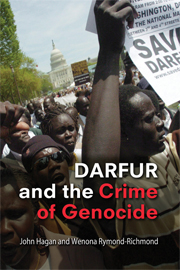Book contents
- Frontmatter
- Contents
- Glossary
- List of Characters
- Prologue: On Our Watch
- Darfur and the Crime of Genocide
- Settlement Cluster Map of Darfur, Sudan
- 1 Darfur Crime Scenes
- 2 The Crime of Crimes
- 3 While Criminology Slept with Heather Schoenfeld
- 4 Flip-Flopping on Darfur with Alberto Palloni and Patricia Parker
- 5 Eyewitnessing Genocide
- 6 The Rolling Genocide
- 7 The Racial Spark
- 8 Global Shadows
- Epilogue: Collective R2P
- Appendix: Genocidal Statistics
- Notes
- Index
- Titles in the series
1 - Darfur Crime Scenes
Published online by Cambridge University Press: 05 June 2012
- Frontmatter
- Contents
- Glossary
- List of Characters
- Prologue: On Our Watch
- Darfur and the Crime of Genocide
- Settlement Cluster Map of Darfur, Sudan
- 1 Darfur Crime Scenes
- 2 The Crime of Crimes
- 3 While Criminology Slept with Heather Schoenfeld
- 4 Flip-Flopping on Darfur with Alberto Palloni and Patricia Parker
- 5 Eyewitnessing Genocide
- 6 The Rolling Genocide
- 7 The Racial Spark
- 8 Global Shadows
- Epilogue: Collective R2P
- Appendix: Genocidal Statistics
- Notes
- Index
- Titles in the series
Summary
The Mass Graves of Darfur
“I was hiding and saw this,” Mohamed explained. “I saw them take fifty-two men from my village, including my cousin, and they took them to the edge of the mountain, made them go on their knees, put the gun in their mouths, and shot each one of them.” He heard the attackers say that “we came here because we want to kill all the Black people.”
Mohamad is a member of the African Zaghawa tribe who lived in a small village near Karnoi in North Darfur. The Sudanese government feared the Zaghawa were leading a rebellion and targeted them early in 2003. Mohamed buried the last bodies and set out on a dangerous journey to a refugee camp in the neighboring Chad, where he became one among more than 200,000 Darfurian refugees. He was also one of those interviewed in the U.S. Department of State Atrocities Documentation Survey.
After patiently providing a detailed description of the attack and the attackers, and the names of slaughtered family members and villagers, Mohamed concluded in despair, “I just want to say the United Nations has come too late; there are too many people who have already died.” Four years later, the United Nations had still not arrived in sufficient force and numbers, and the toll of the dead continued to mount.
- Type
- Chapter
- Information
- Darfur and the Crime of Genocide , pp. 1 - 30Publisher: Cambridge University PressPrint publication year: 2008

